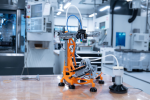
Generative Machine introduces new AI-generated open-source 5-axis FFF desktop 3D printer
3dprintingindustry.com
UK-based robotics engineering startup Generative Machine is developing an open-source 5-axis fused filament fabrication (FFF) system by using Autodesks Fusion 360 software.By moving beyond the limitations of conventional 3-axis FFF 3D printers, which struggle with overhangs and complex geometries, the new system offers greater flexibility in part orientation with a tilting build platform. A multi-axis approach reduces material waste, improves surface quality, and enables the production of intricate designs that would typically require industrial equipment.According to Ric Real, PhD, Co-Founder of Generative Machine, when generative design is combined with parametric design methods, machine dimensions and performance characteristics can be dynamically adjusted, allowing new configurations to be generated instantly.Imagine just defining the required build volume, updating the parametric base configuration, and automatically regenerating an optimized machine to these new dimensions Its not difficult to see the concept of self-designing products and machines begin to emerge, and we can do it all in Fusion, he explained.Generative Machines 5-axis FFF 3D printers beta version. Photo via Autodesk.Leveraging generative design and multi-axis motion control According to Autodesk, Fusion 360s Generative Design feature played a key role in the machines structural development. The tool applies artificial intelligence (AI) and cloud computing to generate multiple design alternatives based on input parameters such as material properties, manufacturing constraints, and performance requirements.By exploring a range of possible configurations, the software refines each design for efficiency and durability. Optimizing the machines mechanical structure through this process enhances its strength-to-weight ratio while reducing unnecessary material usage.Moreover, Fusion 360 also facilitated the overall design and development of the beta version. The entire printer was modeled within the software, streamlining the iteration process.In addition to the machine itself, the UK-based startup used Autodesk Fusion to prototype metal components manufactured separately through an unspecified 3D printing method. Post-processing with CNC machining ensured these components met strict tolerances and maintained precise alignment between the printers moving axes, a critical factor in multi-axis systems where minor misalignments can significantly impact print accuracy.For motion control, the engineering startup is utilizing Duet3Ds ecosystem for motion control, enabling high-precision part production with closed-loop integration. Duet3Ds control boards, combined with RepRap firmware, provide flexibility in machine configuration, making it one of the few setups suitable for a 5-axis FFF printer.Integrating a single-board computer with the control board allows for the development of additional plugins, further expanding the platforms capabilities, highlighted Andrew Everitt, Co-Founder of Generative Machine.Fusion 360s sheet metal tools were used to design the electronics enclosure, ensuring a precise and functional housing for internal components. Custom printed circuit boards (PCBs) were also explored using Fusion Electronics, allowing Generative Machine to optimize the systems electrical architecture for a 5-axis platform.Expanding access to this technology, Generative Machine aims to make advanced 3D printing techniques more widely available to desktop users.Metal 3D printed parts post-processed using CNC machining. Image via Autodesk.Developments in 5-axis 3D printers Generative Machines 5-axis 3D printer joins the lineup of existing systems in the market. Last year, Austrian AM startup VENOX launched the V-REX, a 5-axis composite 3D printer designed for industrial and R&D applications. Having been developed since 2022 with support from Austria Wirtschaftsservice (aws) through the PreSeed DeepTech grant, the printer features a continuous fiber print head for aligning materials like carbon fibers along their natural direction, enhancing part strength.Its automatic tool changer supports up to six different print heads, enabling multi-material printing. With a print volume of 600 x 400 x 400 mm and extrusion temperatures reaching 500C, the V-REX accommodates a wide range of thermoplastics and composite materials. VENOX specializes in high-strength, multi-material 3D printing, integrating sensors, conductors, and hybrid manufacturing techniques in a single build.In 2020, Polish 3D printer manufacturer VERASHAPEs VSHAPER division introduced the VSHAPER 5AX, a 5-axis FDM 3D printer with machining capabilities aimed at engineering applications. Developed to overcome the limitations of conventional layer-by-layer printing, the system features a spinning and tilting build platform that enables multi-directional filament deposition, reinforcing part strength across multiple axes and reducing the need for support structures.The 5AX supports up to six interchangeable tool heads, including options for multi-material printing, milling, drilling, and burnishing. Originally announced in 2017, the system was developed with support from the Polish National Research and Development Center and underwent an open innovation program in 2018 to refine its design based on industry feedback.What3D printing trendsshould you watch out for in 2025?How is thefuture of 3D printingshaping up?To stay up to date with the latest 3D printing news, dont forget to subscribe to the 3D Printing Industry newsletter or follow us on Twitter, or like our page on Facebook.While youre here, why not subscribe to our Youtube channel? Featuring discussion, debriefs, video shorts, and webinar replays.Featured image shows Generative Machines 5-axis FFF 3D printers beta version. Photo via Autodesk.
0 Comments
·0 Shares
·62 Views


